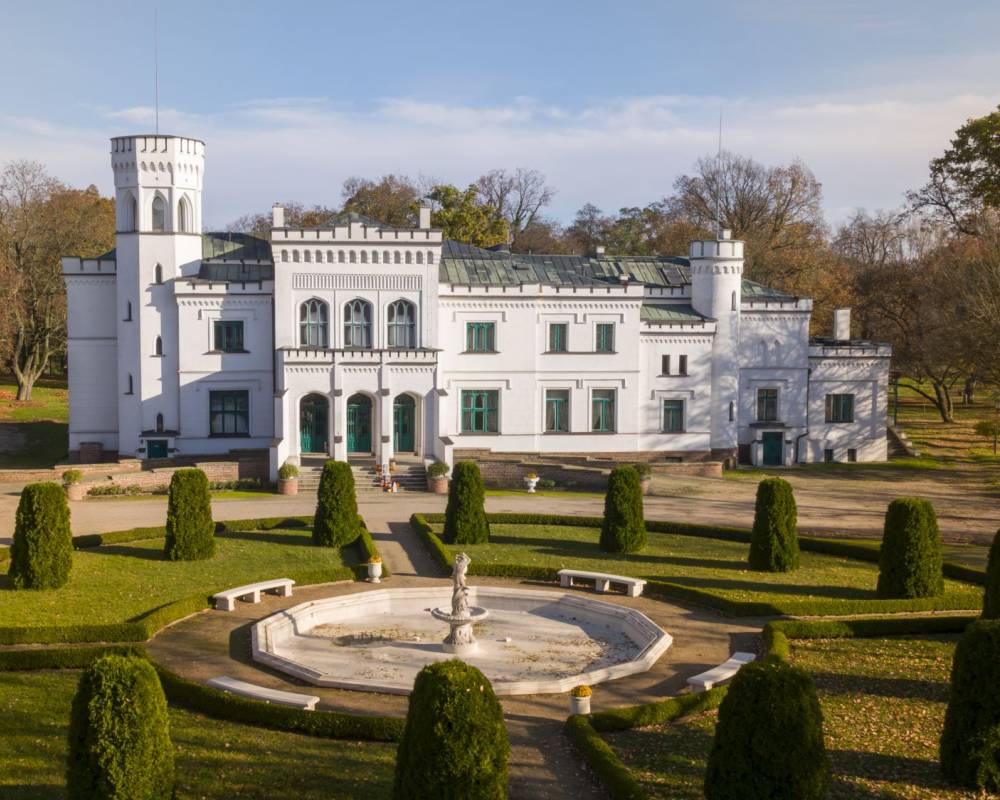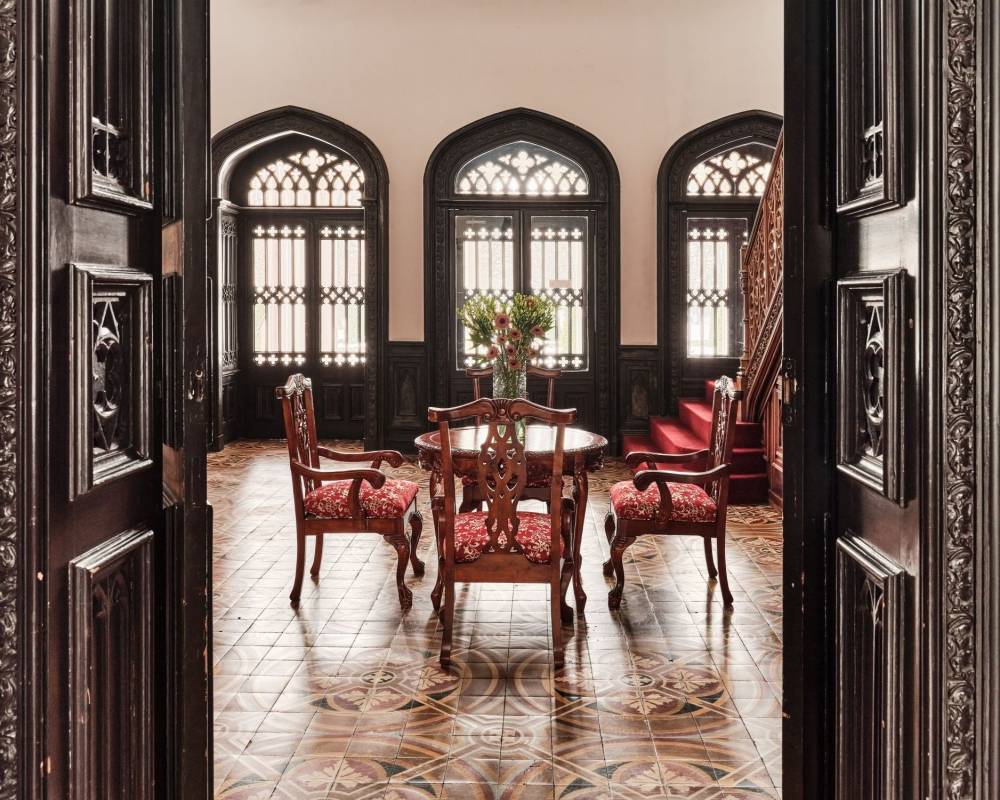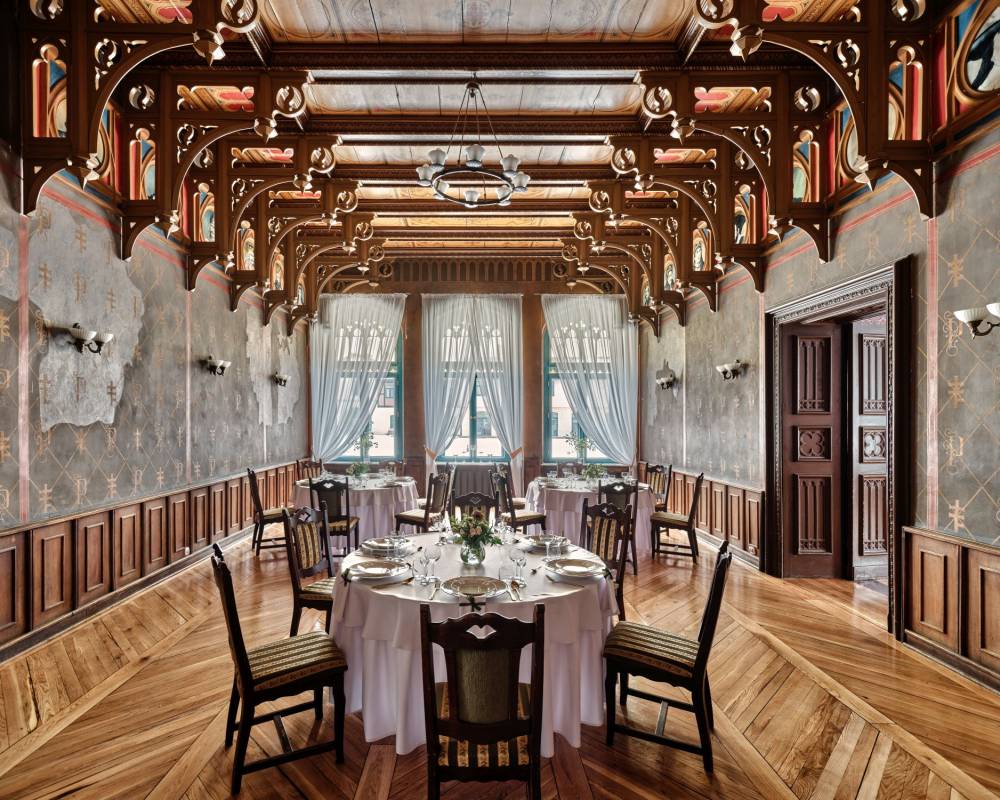The centre's biggest attraction is the historic chateau from 1866 in the English Neo-Gothic style. Its stylish exterior rises majestically above the manicured lawns and gravel alleys, attracting attention from the moment you enter the park beyond the gate.
The palace is a brick two-storey building with an irregular ground plan, resting on vaulted cellars. Its asymmetrical body consists of segments of different sizes, covered by low roofs hidden behind decorative crenelations.
The dominant element is the east-facing central risalit of the front elevation. It is preceded by a single-storey portico annex with three pointed arches. In addition, the body of the palace was enriched with two towers. The taller, octagonal one is in the northern part of the front elevation. The second, slightly lower and cylindrical in shape, adjoins from the south. The five-storey main body has a projecting risalit preceded by a porch with a terrace. Rectangular windows with the characteristic Tudor arch are set in moulded frames.
The rooms in the interior of the Palace are arranged in two- and three-bay layouts. On the ground floor they form an amphilade, while on the first floor they are connected to a corridor running along the building.
The palace in Będlewo is a unique building whose layout and interior design have been preserved almost unchanged.
Visitors to the Palace are greatly impressed by the richly decorated rooms of the ground floor. The magnificent entrance hall running through two floors opens a sequence of rooms. Attention is drawn to the original floor and representative wooden staircase with an openwork carved balustrade, in which the coat of arms of the Potocki family - Pilawa is incorporated. Opposite the hall is the Ballroom, from which to the left you can enter two room: The Knights' Hall and Fireplace room.
The largest room in the Palace is the Knights' Hall. It is a beautiful hall preserved in Neo-Gothic decor, lit by three windows with wooden joinery, with a polychrome beamed ceiling and with openwork, sculptural brackets. Grey polychromes have been preserved on the walls here in imitation of cursive upholstery with the coat of arms and the initial P (of the Potocki). Between the ceiling supports, there are circular tondos with a partially restored polychrome depicting the post of Polish kings. The Knights' Hall is often used as a dining room for guests of conferences and workshops organised here.
Next to it is the former library, which features a beautiful wooden fireplace, restored fabric wallpaper, panelling and stucco on the ceiling. Now known as the Fireplace Room, it is often used as a restaurant room where a breakfast or lunch buffet is prepared.
Leaving the Ballroom to the right, we enter the Rococo Room. On its walls we will find restored fabric wallpaper, gold embellishment and stucco. The Rococo Room has an exit to the porch of the covered terrace. From here, in summer, you have a wonderful view of the garden's vegetation, beautiful flower beds, fragrant, colourful flowers and, in the distance, the park and ponds.
From the Rococo Room, we enter the Round Lounge also known as the Blue Room or the Statue Room, where decorative maroon niches have been recreated. In these niches probably stood copies of ancient statues. Today, contemporary busts and statues of women stand here. The Statue Room contains the original fireplaces made of white marble and columns supporting the triangular portals above the doors. This original room is ideal for an intimate business or family meeting.
Moving further into the amphilade, we come to a Square Lounge called the Card Room. Its walls are decorated with wallpaper in vertical stripes with a floral pattern.
Walking straight ahead from the Card Room, you enter the Countess' Lounge and then the Round Table Room, which can be used as a small room for business meetings, workshops or private celebrations.
From the Statue Room, we can go to the former sleeping rooms and boudoir. Opposite was the sleeping room of the palace owners, divided into two parts by golden columns. Here an extremely decorative tiled cooker has been preserved. The hand-painted pattern on the tiles depicts vine tendrils. The room now known as the Column Room also contains an antique piano.
From the former bedroom, one side went to the bathrooms (this part is now inaccessible to guests) and the other to the study of the master of the house. In the former study, a magnificent fireplace of black marble interspersed with white veining impresses. The current name of the room is the Golden Lounge.
From the main hall, a wooden staircase leads up to the first floor, where there are rooms for other family members and guests. Today, there are atmospheric suites for guests and honeymooners, decorated in various styles.







